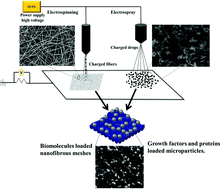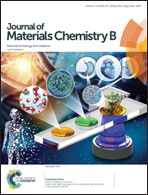Multidrug-eluting bi-layered microparticle-mesh scaffolds for musculoskeletal tissue regeneration†
Abstract
Stem cell-based tissue engineering necessitates the development of a biocompatible scaffold, as a structural support, that provides a continuous supply of bioactive molecules for specific lineage differentiation. While incorporating bioactive molecules within a scaffold to improve stem cell differentiation has been reported in the literature, there is minimal evidence of any scaffold that can deliver a customized concoction of both hydrophobic and hydrophilic bioactive molecules to induce in situ lineage differentiation without any external supplements. In this study, we established a bioactive, drug-eluting bi-layered microparticle-mesh scaffold (BMMS) using the electrospinning technique. This BMMS was co-encapsulated with hydrophobic dexamethasone (in the mesh), hydrophilic ascorbic acid and β-glycerophosphate or proline (in the microparticles). We hypothesized that a sustained-releasing BMMS can direct in situ specific lineage differentiation of MSCs (e.g. osteogenic and chondrogenic) in a minimally supplemented culture environment into musculoskeletal tissues. The characterization of this BMMS revealed good encapsulation efficiencies of the bioactive molecules with sustained-releasing capabilities. The release kinetics of each drug was further analyzed using mathematical drug-releasing models. These scaffolds were subsequently shown to have potential for osteogenic or chondrogenic lineage differentiation from mesenchymal stem cells (MSCs) in a minimally supplemented culture medium.

- This article is part of the themed collection: Editor’s Choice: Scaffold Engineering


 Please wait while we load your content...
Please wait while we load your content...